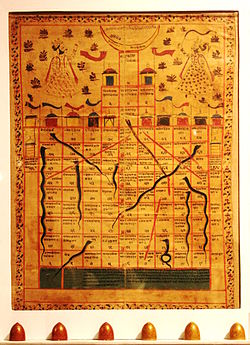Gyan chauper

Jain Gyan Chaupar on cloth, National Museum (India, 19th century)
|
|
| Genre(s) |
Board game Race game Dice game |
|---|---|
| Players | Minimum 2 |
| Skill(s) required | entirely based upon probability |
Gyan Chauper (ज्ञान चौपड़ in Hindi sometimes spelt gyan chaupar) is a dice game from ancient India, popularly known as Snakes and Ladders. It was from India that it spread to the rest of the world. It was a very popular game to be played its main purpose was not only entertainment but also to teach morality. The central concept is liberation from bondage of passions. So the players move from the lower levels of consciousness to higher levels of spiritual enlightenment and finally to Moksha.
The Gyan Chauper board is in a grid pattern. The Hindu Gyan Chauper has numerous formats whereas the Jain Gyan Chaupers are standardized with 84 numbered squares in a 9x9 pattern. The board game is in the human shape-the universal being. The top most part of the board is the heavenly abode or the Moksha dwar akin to the head of the cosmic being. A protruding square on the extreme bottom left and one square on each side of the board is indicative of its legs and arms. Even the way the snakes and ladders have been placed on the board does not change whereas they vary widely in Hindu, Muslim, Buddhist Gyan Chaupers.
Chauper as a dice game has been played in India since prehistoric times. The earliest evidence of it has been found in the Indus Valley civilisation. Ivory and bone dices of all shapes and sizes with dots on them have been found from Lothal, Kalibangan, Alamgirpur, and so on. Game boards have also been found at various sites. A potsherd with a chauper design drawn on it has been discovered from Lothal and Nagarjunakonda. A recent excavation from Rakhighari in Haryana discovered games boards and game pieces in terracotta and stone. Many pyramid shaped Game pieces made in stone,ivory and terracotta have been discovered from these ancient sites.
Chauper has also been mentioned in a hymn in the Rig Veda, which expresses the lament of the player over his loss of wealth and spouse. The Vedic people used Vibhidaka (small brown nuts) as dice. This tradition of ritualistic gambling is still seen today as Hindus play the modern version of this game during Diwali.
The Mahabharata also mentions the game of Chauper in which Yudhishthira loses everything to his cousins. The Skanda Purana mentions Shiv and Parvati playing the game of Chauper. This scene has been beautifully shown in a sculpture in the Ellora caves in Aurangabad.
...
Wikipedia
